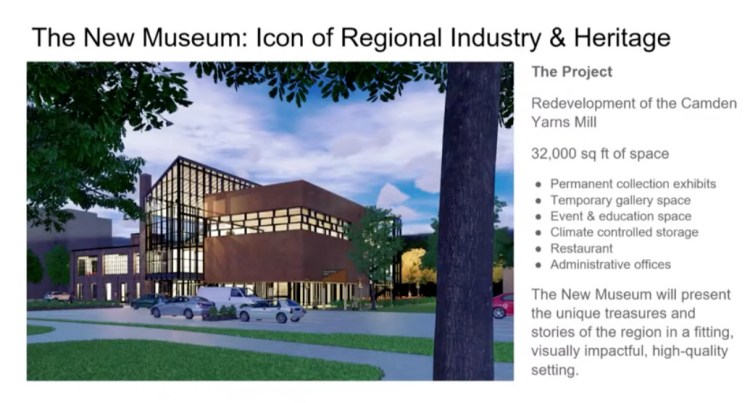LEWISTON — A new beginning for Museum L-A has been in the works for years, but officials say the “time is now” for the rollout of a capital campaign and rebrand that hopes to position the museum as a cultural landmark for the region.
Rachel Ferrante, the museum’s new executive director, told Auburn officials last month that part of the rebranding will include a name change and new “brand identity that will broaden the museum’s appeal and speak to diverse audiences.”
Ferrante and other museum officials were in Auburn as part of a pitch to local governments, in hopes of raising a chunk of the $17 million needed to build the new museum at the former Camden Yarns Mill on Beech Street in Lewiston’s riverfront.
During the City Council workshop, Ferrante said the new museum, with its ambitious design, can become a destination for the region, driving economic development from jobs and tourism.
The 36,000-square-foot museum, designed by Platz Associates, will feature large spaces for a permanent collection and temporary galleries, classrooms, a cafe and restaurant, design lab and more.
Ferrante took over as the new executive director of Museum L-A in September. She graduated from Bates College and spent the last decade working at the Metropolitan Museum of Art in New York. She told Auburn officials that she moved back to the area to raise a family and chose the job of driving the new museum, “because of what I believe it can do for this region.”
Ferrante said Thursday that the “cultural and economic value of a new museum is clear,” and believes it “will become an icon of history of heritage.”
She pointed to examples of successful museums with similar roles as “icons of cities and heritage,” like the Mill City Museum in Minneapolis-St. Paul and the John Heinz History Center in Pittsburgh.
The new building has been a long time coming, with the museum taking over ownership of the Camden Yarns Mill in June 2009. It wasn’t until 10 years later that the museum board selected Platz Associates to design the new museum on the site, which lies adjacent to Simard-Payne Memorial Park.

Museum L-A plans to build a new museum at the site of the former Camden Yarns Mill at 1 Beech Street in Lewiston. The solid front brick section with a tower will be kept. MuseumL-A photo
Tom Platz spoke to the Auburn council in November, stating that the Twin Cities are at a “real crossroads,” with tremendous opportunity to create something that draws people to the region. He said if people look around Maine, other successful areas have a cultural draw that brings people there.
The new museum could be a “first-class museum with major cultural events,” he said. “This is the first opportunity I’ve seen I think that we have the opportunity to do something like that.”
The museum is asking the city to approve a $1.5 million donation to the capital campaign, which would come from the city’s American Rescue Plan Act funds. It is hoping to raise a total of $4.5 million from local governments, and is presenting the campaign details to Lewiston officials Tuesday.
Lewiston has allocated all of its ARPA funds to infrastructure projects. Auburn City Manager Phil Crowell said allocating funds to a nonprofit is allowable under ARPA, as long as the nonprofit meets the same program requirements. He said that means the money must be spent by 2024, with the project complete by 2026.
The museum would also fall under the economic development goals of the funding.
Ferrante said the museum sees both cities as partners and that both mayors have been asked to serve on the museum’s board starting in 2022. Ferrante said she also presented to the Androscoggin County commissioners Nov. 17 and she’s felt good about both meetings so far.
The remaining money is expected to be raised through federal and state sources, major donors, foundations and through the general capital campaign. Roughly $1 million has been raised.
If the capital campaign is successful, Ferrante said they hope to break ground in the spring of 2023, with a hopeful opening in the spring or summer of 2024.
Other Auburn officials said the new museum fits into Auburn’s long-term strategies and could provide an “anchor point” for walkable connections to the nearby Bonney Park, Moulton Park and Community Little Theatre.
Councilor Katie Boss called the plan a “critical vision and so valuable beyond tourism and revenue.”
She said when she moved to the region eight years ago, she pulled up Google Maps to find points of interest and one of the first places she visited was Museum L-A.
“It made me feel rooted and I bought a house and raised a family here,” she said.
Send questions/comments to the editors.




Comments are no longer available on this story